Ontario
| |
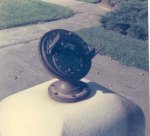 |
London |
Ontario |
Canada |
Heliochronometer |
Dial 62 |
| A brass Pilkington-Gibbs heliochronomer aligned to the celestial equator. Rotate the helioscope until the sun shines from the upper hole to the lower plate, then read the time from an accompanying dial. The Pilkington-Gibbs dial includes a patented cam mechanism to adjust for the Equation of Time. |
| |
| |
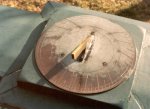 |
Long Island |
New York |
USA |
Horizontal Dial |
Dial 100 |
| A bronze circular horizontal dial about 18 inches in diameter. At the edge of the dial set in concentric rings are the hour lines, half hour lines, quarter hour and five minute marks. Hours are in Roman numerals from 5am to 7pm. Has a thick brass gnomon. |
| |
| |
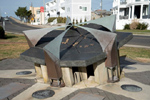 |
Longport |
New Jersey |
USA |
Sun Alignment |
Dial 1004 |
| This concrete and bronze dial is really an alignment sculpture, honoring events from Armistice Day (Nov 11, 1918) to Pearl Harbor (Dec 7, 1941). A five-vaned support casts a shadow onto brass medallions on the time and date of the event such as the 11th hour of the 11th day of the 11th month for Armistice (Veterans) Day. Surrounding the dial are five bronze plaques representing the different branches of the U.S. armed forces. |
| |
| |
 |
Los Altos |
California |
USA |
Obelisk or Vertical Gnomon |
Dial 498 |
| A triangular entry canopy 13 feet height by 128 feet wide by 26 feet deep at the Georgina Blach Intermediate School casts a shadow on the front pavement walkway. The pavement is etched with a gnomonic projection to show the hours and seasons. The dial was created by architects Lisa Gelfand and Andrew Davis who did considerable research for the dial. Their design was submitted to the school district for approval. It's a fun sundial and the students and teachers love it. |
| |
| |
|
Los Angeles |
California |
USA |
Sculpture/Artwork |
Dial 309 |
| A sundial sculpture by Martha Oathout Ayers. More information about this dial is needed. |
| |
| |
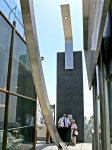 |
Los Angeles |
California |
USA |
Sun Alignment |
Dial 593 |
| A bronze-faced meridian arc dial 18 feet long, 13.5 feet high and 7 inch wide. Displays the meridian line and is inscribed with month and day markings, seasonal and lunar indicators and constellation figures. An overhead lens projects a solar image on the inscriptions. A large adjacent symbol is positioned to indicate which set of date markings is to be read from the meridian line. In a modern twist, photoelectric sensors embedded in the face of the arc are activated by the transiting spot of sunlight and send a signal to illuminate LED indicators on the 22 foot wide stainless steel ecliptic chart overhead, lighting up the stars of the constellation through which the sun is passing. |
| |
| |
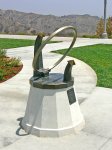 |
Los Angeles |
California |
USA |
Equatorial Dial |
Dial 77 |
| A bronze equatorial ring dial with taut wire gnomon on concrete pedestal. Ring is inscribed with hour, ten-minute and minute lines. Plaque states the dial indicates correct watch time so observatory staff periodically rotates clamped ring to correct for EOT, longitude and DST. Dial is located adjacent to the Astronomers Monument atop which is a large bronze armillary. The monument recognizes Hipparchus, Copernicus, Galileo, Kepler, Newton and Hershel. The sundial was originally built into the base of the Astronomers Monument but was relocated a few feet to the south during the 2002-2006 remodeling to allow visitors to more closely approach the dial. The dial sits atop a concrete pedestal. |
| |
| |
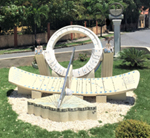 |
Los Rios Santo Domingo |
Distrito Nacional |
Dominican Republic |
Compound Dial |
Dial 903 |
| This highly decorated monument sundial is composed of three sundials (Horizontal, Polar and Equatorial) with a common gnomon. All of the dials are built mainly of limestone. The large polar dial (wings), small horizontal dial (tail) and gnomon (body) recreate a “hummingbird”, the universal symbol for diabetes. (The hospital specializing in diabetes is only 500m away). The dials are delineated in half hours and have a variety of graphics on all three dials. In the same location, albeit separated there is another equatorial clock that is five times smaller and has a custom gnomon in the shape of the "little hummingbird”; this sundial is mounted on top of a column and has been adjusted to the local solar time. Nearby is a plaque with the equation of time. |
| |
| |
 |
Louisa |
Virginia |
USA |
Cylindrical Dial |
Dial 594 |
| An internal cylindrical dial built in a 16 foot diameter, 48 foot tall farm silo now located on a public golf course. The rim of the open top of the silo provides an elliptical shadow line on the inner wall of the silo. This is marked out with red hour lines and black date lines using the low point of the shadow on the wall as the time marker. The artwork has "three panels representing the continuity of man's perceptions of space: past, present, and future. In an abstract sense, the sundial represents the scientific, emotional, and philosophical struggles and triumphs of mankind." Contact Tanyard Country Club Golf Pro Shop at 540-967-1889 to ensure the silo door is open. |
| |
| |
|
Louisbourg |
Nova Scotia |
Canada |
Horizontal Dial |
Dial 391 |
| A small horizontal dial 28 cm in diameter on a limestone pedestal. The dial shows local hours with half-hour lines from 4 am to 8 pm in Roman numerals. Trefoils are interspersed with the hour labels. A south-pointing crescent or moon sits across the sub-style and a representational daisy or sun sits below the center of the dial. The base is a limestone pedestal 85 cm tall. The base is a limestone pedestal 85 cm tall.
The dial is located in the Fortress of Louisbourg run by the Parks of Canada. The dial is a modern reproduction of a slate dial excavated at the site. |
| |
| |
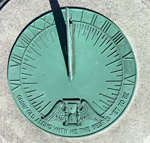 |
Louisville |
Kentucky |
USA |
Horizontal Dial |
Dial 1025 |
| The classic brass horizontal sundial is 10-1/2 inches in diameter with a large chapter ring of Roman hours marked from VI to VI. Noon is marked by "O". However, the hour and minute lines that extend inward and run in quarter hours from 4am to 8pm. At the south end of the dial is the traditional hour glass with wings. The gnomon is also classic with a bird supporting the style. The dial sits on a granite cap 7 inches thick held by a decorated and fluted column 22-1/2 inches tall. This in turn sits on a two-tier dais 14 inches high with the top tier inscribed "VAUGHAN" for the family plot. |
| |
| |
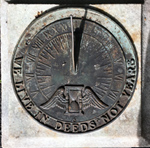 |
Louisville |
Kentucky |
USA |
Horizontal Dial |
Dial 1026 |
| This horizontal bronze dial is 9 1/2 inches in diameter with Roman hour marks from V to VII, delineated in quarter hours. Noon is marked by a thin trapezoid. Outside the dial is a surround of another ring with semi-circular words around the dial: "We live by deeds, not years". A classic hour glass with wings decorates the dial face. The gnomon is in good condition, but slightly bent. The dial sits atop a white marble pedestal 45 inches tall. The pedestal sits on a base two-foot square approximately 13 inches in height. Above the base the pedestal tapers upward, narrowing to an 11 inch square that holds the dial and the surround. |
| |
| |
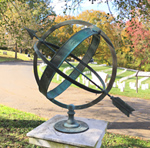 |
Louisville |
Kentucky |
USA |
Armillary Sphere |
Dial 1027 |
| This bronze armillary has equatorial and meridian bands 18 inches in diameter. The equatorial band is 2 inches wide with Arabic Hour marks on the inside of the band and zodiac symbols on the outside. The gnomon rod is a traditional arrow 31 inches long. The sphere’s metal base is 7.5 inches in diameter and is decorated with the signs of the zodiac. The armillary sits atop a graceful round column 37.5 inches tall, including the 14x14x2 inch cap. The base is 16x16x2.5 inches. This in turn sits on a two-tier dais 10 inches high with the top tier inscribed "RIDGE" for the family plot. |
| |
| |
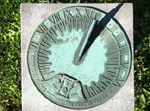 |
Louisville |
Kentucky |
USA |
Horizontal Dial |
Dial 1029 |
| The classic brass horizontal sundial is 11 inches in diameter with a large chapter ring of Roman hours marked from VI to VI. Noon is marked by "O". However, the hour and minute lines that extend inward and run in quarter hours from 4am to 8pm. At the south end of the dial is the traditional hour glass with wings. The gnomon is also classic with a bird supporting the style. Unfortunately the dial is aligned to magnetic north. The dial sits on a thick square cap 12 x 12 x 5 inches. Beneath is a graceful round pedestal 24 inches tall that rests on a square plinth 12 x 12 x 5 inches. |
| |
| |
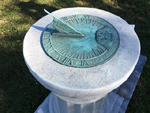 |
Louisville |
Kentucky |
USA |
Horizontal Dial |
Dial 1032 |
| The Griswold-style bronze dial is 11 inches (28 cm)in diameter and closely aligned to true North. The gnomon is set at a generic angle of 40°, while the site latitude is 38°. The dial sits atop a fluted stone column 38 inches (96.5 cm) tall that has a round cap of 16.5 inches (42 cm) diameter and 4 inches (10 cm) thick. The column sits on a two-part square base with an upper tier that is 17.75 inches (44.5 cm) on each side and 3 inches (7.6 cm) high and a bottom tier that is 22 inches (56 cm) on each side and 7.5 inches (19 cm) high and engraved with the family name “STEIN.” |
| |
| |
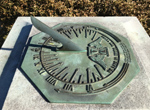 |
Louisville |
Kentucky |
USA |
Horizontal Dial |
Dial 1038 |
| This 11-inch (28cm) octagonal bronze horizontal dial uses arrowheads as a subtle design element. The 14 hour lines are represented as long arrows aimed at the base of the gnomon and are delineated to quarter hours. . The hours are marked in Roman numerals, but only from 6AM to 6PM. There are three curved lines of unequal length that partially encircle the dial indicating the amount of daylight in the and each one ends with a pointed tip. The marker for Noon resembles the Roman symbol for Mars, with its arrowhead pointing straight up. A winged hourglass graces the southern portion of the dial face. |
| |
| |
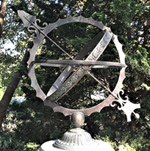 |
Louisville |
Kentucky |
USA |
Armillary Sphere |
Dial 1040 |
| This bronze armillary’s equatorial ring is 1.25 inches wide and 16.25 inches in diameter. The inside of the ring has Roman numerals denoting the hours from 5:00 AM to 7:00 PM. The outside of the ring is decorated with dogwood blossoms, a traditional Christian symbol of resurrection. The serrated meridian band is 1.25 inches wide and it has an outside diameter of 18 inches. The small horizontal band is 0.5 inches wide. The arrow is 29.5 inches long. It points in a westerly direction, meaning the dial is decorative but not useful for telling time. |
| |
| |
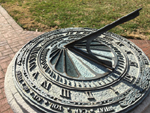 |
Louisville |
Kentucky |
USA |
Horizontal Dial |
Dial 1043 |
| This elegant brass horizontal dial was custom made for this site, as evidenced by the word GARDENCOURT and the site’s latitude 38° 15’ cast into the plate at the bottom. The dial is 13.75 inches in diameter, with a design of a series of concentric rings. The innermost ring has 17 lines radiating out from the foot of the gnomon toward the Roman numerals in the third circle. Each of these lines is connected by a graceful curve at its end to the adjacent line, creating a chestnut leaf motif in the inner circle. The next circle is a chapter ring of Roman hours marked from IV to VIII, embellished at the bottom with a stylized oak-leaf. A thin decorative band surrounds that ring. The outermost band contains the inscription and the name of the estate. The gnomon is a simple wedge, cut at the correct angle for the site. Unfortunately it is bent slight off true north. |
| |
| |
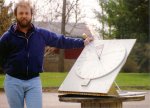 |
Louisville |
Kentucky |
USA |
Equatorial Dial |
Dial 234 |
| Park rangers set up a 16 x 20 inch portable equatorial sundial. The dial is used for teaching a solar energy class. |
| |
| |
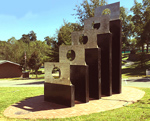 |
Lucedale |
Mississippi |
USA |
Sun Alignment |
Dial 820 |
| This is a Veteran's Memorial consisting of a set of five large stainless steel panels with holes that guide sunlight to strike a memorial plaque. The alignment is designed to commemorate the signing of the armistice ending World War One, illuminating the plaque on Nov 11th at 11:00AM |
| |
| |
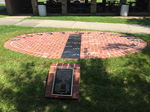 |
Lucedale |
Mississippi |
USA |
Analemmatic Dial |
Dial 834 |
| This analemmatic dial (sometimes called a human sundial) is designed for children. Approximately 16 ft wide, it is constructed of red brick with steel hour marks. The numbers for standard time are large silver and the numbers for daylight saving time are smaller and black. A black steel walkway is located in the center of the dial with embossed months of the year. Children stand on the month. Their shadow marks the time. Large numbers are standard time. Small numbers are daylight saving time. |
| |
| |
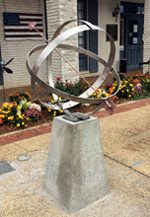 |
Lucedale |
Mississippi |
USA |
Armillary Sphere |
Dial 849 |
| The armillary is constructed of stainless steel with rings approximately 34 inches in diameter. The equatorial ring is a 3-inch band with 1-inch cast bronze Arabic hour numbers showing standard time and 1/2 inch cast bronze numbers for Daylight Saving Time. The other rings are unconventional. Rather than a horizontal ring, the ring is canted to match the latitude. The solstial ring that traditionally runs completely over the N-S vertical meridian is only 3/4 complete, creating an open area from the upper portion of the equatorial band to the southern pole that allows better viewing of the equatorial time ring when standing behind the armillary. The dial can be adjusted for the equation of time by rotating the equatorial ring to align on a plate with month marks set to the equation of time plus longitude offset, allowing the sundial to tell civil time. |
| |
| |
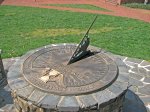 |
Lynchburg |
Virginia |
USA |
Horizontal Dial |
Dial 627 |
| A 48 inch diameter bronze horizontal dial on a stone pedestal. Polar gnomon includes a scroll and stylized peacock. Dial furniture includes an hour glass and eagle wings. The perimeter around the dial is inscribed, "TIME LIKE LIFE CANNOT BE RECALLED." The dial sits atop a cylindrical mortared stone pedestal. |
| |
| |
 |
Macedon |
New York |
USA |
Sun Alignment |
Dial 408 |
| A cornfield maze for the summer of 2000 at Long Acre Farms. Theme called "Lost in Time" features a number of sundials. The 400 x 500 foot cornfield maze, called the "largest living sundial", is in the form of a smiling sun with 12 corn hedge "rays" from 8 am to 6 pm that align in azimuth to the hour and half hour for Labor Day, 2000. Within each hedge is a vertical pole holding an "Eye of Kala" (an annulus) 12 feet above the ground that casts a spot of light across a hedge clearing at the appointed time to a sign at ground level. At the center of the maze is a horizontal dial with a 12-foot gnomon. This gnomon forms part of the smiling sun's nose when seen from the air. Just outside the corn hinge is an analemmatic sundial for visitors to tell time before going through the hinge. In the hinge, visitors are given a small altitude card dial that tells Eastern Daylight Time from June - Oct. Admission fee. |
| |
| |
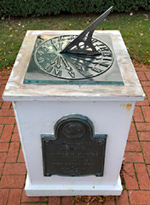 |
Mackinac |
Michigan |
USA |
Horizontal Dial |
Dial 183 |
| ca 16 in. square brass horizontal dial. Hours from 5am to 7pm in Roman numerals. Arrows radiate from the foot of the gnomon to each hour and three stars are located at the south end of the gnomon. The dial originally sat on a sightly tapered white concrete square pillar. When the dial was moved near the Jockey Club, the pedestal was redone in a square wood column painted white. A memorial plaque original on the south side of the pedestal is now on the east side. The dial was erected in memory of James R. Hayes, manager of The Grand Hotel from 1890 to 1900. The dial now sits in a small brick plaza. |
| |
| |
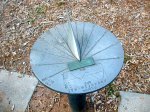 |
Macon |
Georgia |
USA |
Horizontal Dial |
Dial 226 |
| A horizontal dial 16 inches in diameter located beside the observatory, just outside the museum. Includes hour markings for EST and DST and an EOT graph. Hour lines corrected for longitude. Mounted on a 24 inch high pedestal low enough for children to enjoy. |
| |
| |
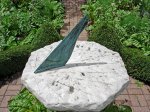 |
Madison |
Wisconsin |
USA |
Horizontal Dial |
Dial 729 |
| An octagonal limestone horizontal dial with bronze gnomon. Hour lines are hand chiseled with no hour numerals. The noon line includes an inset bronze triangle.
Viewing the dial within the garden requires an admission fee. |
| |
| |
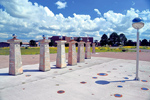 |
Magdalena |
New Mexico |
USA |
Obelisk or Vertical Gnomon |
Dial 981 |
| This vertical gnomon sundial sitting on a 46-by-35-foot concrete slab was constructed using concrete piers of a solar mapping radio telescope array that Robert Bracewell originally built near the Stanford University campus. The array was abandon in the 1980's. The 10 piers were moved to the VLA in 2013 and arranged as a vertical gnomonic dial. NASA: "As for most sundials the shadow cast by the central gnomon follows markers that show the solar time of day, along with solstices and equinoxes. But markers on the [Bracewell] radio sundial are also laid out according to local sidereal time. They show the position of the invisible radio shadows of three bright radio sources in Earth's sky, supernova remnant Cassiopeia A, active galaxy Cygnus A, and active galaxy Centaurus A." |
| |
| |
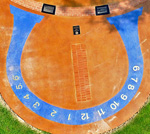 |
Magnolia |
Arkansas |
USA |
Analemmatic Dial |
Dial 800 |
| A 22 by 17 foot analemmatic dial of stained concrete with Arabic hour numerals of polished brass. The dial perimeter and hour numerals are set in a blue decorative polymer "U" arc, appearing as a large mule shoe that represents the university Muleriders mascot symbol. Dial colors represent the royal blue and gold school colors. |
| |
| |
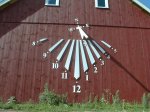 |
Manchester |
Vermont |
USA |
Vertical Dial |
Dial 416 |
| A beautiful vertical declining dial, done in white lines and numerals on the side of a red barn. Made of metal and wood, the overall height is about 15 feet. The dial has a clean, modern design using tapered hour lines and simple gnomon. The Arabic numerals for each hour are graded in size to match the size of their hour line, with the largest at noon and the smallest at 8am and 5pm. |
| |
| |
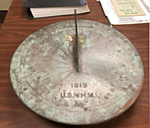 |
Mare Island |
California |
USA |
Horizontal Dial |
Dial 1076 |
| Farenholt sundial for U.S. Naval Hospital Mare Island. Cast bronze, 18 inch (46 cm) diameter circular face, mounted on a cement pedestal 40 inches tall. Only three Farenholt sundials are known to have Spanish mottos: Mare Island is one of them. (Sunnyvale, CA and Hawthorne, NV are the others). We notice other difference from the classic Farenholt sundial: (1) there is no true chapter ring for the hour marks. They are at the end of long hour lines that extend from 4am to 8pm. All other dials are from 6am to 6pm. (2) The hours are delineated in quarter hours. All other dials are delineated in half hours. (3) The gnomon foot is considerably below center (and appears restored) with a raised style edge that is more “art deco” than the curves of other Farenholt gnomons. (4) The naval command is not spelled out. Rather, just the initials “U.S.N.H.M.I”. All other Farenholt dials spell the naval command in full. (5) The date is placed above the command initials. All other dials have the date below the naval command title. (6) There are no Farenholt initials on the dial’s southern edge. All of this may indicate the haste with which the dial was made, perhaps to memorialize those that died in Vallejo due to the 1918-1919 influenza epidemic. |
| |
| |
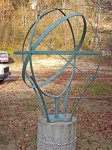 |
Marshall |
North Carolina |
USA |
Armillary Sphere |
Dial 642 |
| An armillary steel ring equatorial dial approximately 4 feet diameter. Hour ring has Roman numerals cut through the ring to show EST. Mounted on a concrete pedestal marked with city name and builder's mark. The pedestal is also marked with Marshall town map coordinates 35.79° N, 82.68° W, which are not the precise coordinates of the dial. Weathered finish is green enamel paint on steel. The concrete pedestal is marked with Marshall city name, builder's mark and approximate coordinates. |
| |
| |
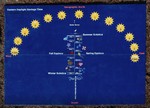 |
Marshfield |
Massachusetts |
USA |
Analemmatic Dial |
Dial 1005 |
| This beautiful and educational analemmatic sundial is painted on the blue background of a 14x10 foot concrete pad. The ellipse itself has a semi-major axis of 76 inches and a semi-minor axis of 48 inches, particular suited for children. The zodiac walkway is nicely painted in white with clean stenciling of the months. The solstices and equinoxes are marked in large letters and the cardinal points are flagged in red. [Note: a number of vendors will make paper or plastic stencils that with a stiff brush create impressive lettering.] The hour marks are bright yellow suns enumerated in standard time and offset for longitude. The paint is covered with a clear sealer (Duromar DF-5610 “Solventless, Zero VOC, UV Stable Clear Polyaspartic Topcoat”) plus a bit of "shark grit" (Duromar DuroTrac "Invisible Traction Grit") to roughen the surface a bit to give some traction. This is similar to the approach taken by John Carmichael for the dial he designed at the University of Arizona, NASS Registry #825. |
| |
| |
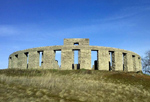 |
Maryhill |
Washington |
USA |
Sun Alignment |
Dial 241 |
| The Maryhill Stonehenge was the first monument in the US to honor the dead of World War I. It is 180-feet across with pillars of reinforced concrete, duplicating, as nearly as possible the original size and design of Stonehenge. The outer circle has thirty 16-foot pillars while the inner circle has forty pillars 9-foot high. Build by a wealthy entrepreneur Sam Hill as a memorial to servicemen of Klickitat County. |
| |
| |
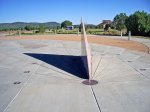 |
McDonald Observatory |
Texas |
USA |
Horizontal Dial |
Dial 771 |
| A monumental horizontal dial on a cast concrete base with a 5 foot high polished granite gnomon. Hour lines radiate from the gnomon root and hour markers with Arabic numerals are placed on a square about the gnomon. Instructions for reading the dial are engraved on the side of the gnomon. |
| |
| |
|
McMinnville |
Oregon |
USA |
Vertical Dial |
Dial 133 |
| 8 x 6 ft Stainless steel and copper The hour lines project beyond the dial face, which is mounted about 12' out from the wall and cast digit-shaped shadows on it. Thus both the hour-lines and stile line are shadows. The dial is mounted on the south face of a tower, structurally an elevator shaft. The bronze plaque at the base contains the inscription. |
| |
| |
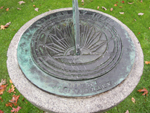 |
Meadville |
Pennsylvania |
USA |
Horizontal Dial |
Dial 905 |
| The sun dial was given to the college in 1909 by the Class of '99 as a memorial on their tenth anniversary. It consists of an elegant bronze dial showing time from 6am-6pm delineated in 15 minute increments. Hours are shown in Roman numerals. The gnomon has the number "99" beneath the style. The dial is mounted on a granite pedestal forty inches in height. |
| |
| |
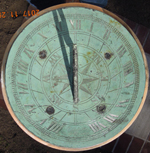 |
Meadville |
Pennsylvania |
USA |
Horizontal Dial |
Dial 906 |
| This patina dial shows lots of wear. Although it sits on an elegant helical pedestal. The dial has a compass rose and from measurements of both the dial and gnomon, it was constructed for London at 51 degrees. This is further supported by the hour extent from 4am to 8pm. The hours are delineated in irregular 5 minute marks with hours shown as Roman numerals. The 6am to 6pm hour lines should be exactly opposite, but are angled toward the gnomon foot. Unfortunately this dial never kept good time in London and certainly can not tell accurate time in Pennsylvania. |
| |
| |
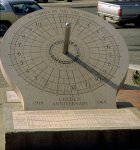 |
Medicine Hat |
Alberta |
Canada |
Equatorial Dial |
Dial 495 |
| The Medicine Hat equatorial sundial was commissioned by the Rotary Club of Medicine Hat to commemorate its 50th anniversary (1918-1968). This is an Erickson equatorial polar dial. The dial is 6 feet 9 inches in diameter, made of pink granite, and weighs 3450 pounds. The dial is supported by an inclined stainless steel gnomon rod 3 inches in diameter, with overall length just over 6 feet. As with many of these dials, there are two equation of time plaques. |
| |
| |
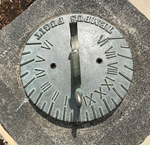 |
Mendota Heights |
Minnesota |
USA |
Horizontal Dial |
Dial 1070 |
| This brass horizontal sundial was donated to the school in or around 1908 by the Visitation School class of 1908. It was moved from St. Paul MN to Mendota Heights, MN in 1966 when the school was relocated. In the spring of 2018 it was moved to a protected garden, but sits on the original 1908 pedestal 3 foot (1m) tall and 18 inches (46cm) square. The original dedication engraved into the pedestal is still plainly visible. The dial itself is approximately 12 inches ( 30 cm) in diameter with raised hour lines on the circumference and raised Roman numeral hour marks on the interior from 6am to 6pm. The dial is in excellent condition, but in 2017 a new brass gnomon was cast as a replacement for the missing simple triangular gnomon. The new 1 inch (2.5 cm) wide gnomon is in the shape of a crescent moon. Although aligned with the noon line, this gnomon will never cast a shadow. telling correct time. It is sad that this 114 year old sundial has been reduced to nothing more than an artistic sculpture. |
| |
| |
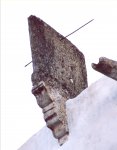 |
Merida |
Yucatan |
Mexico |
Vertical Dial |
Dial 537 |
| This is south-facing vertical or scratch dial with horizontal gnomon and located on the roof at the front of an early church monastery cloister. The stone dial is approximately 3 feet square. The north face is similarly inscribed. This is among the earliest sundials in North America. |
| |
| |
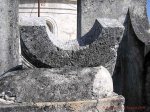 |
Merida |
Yucatan |
Mexico |
Equatorial Dial |
Dial 538 |
| Generally identified as an equatorial, this stone cylindrical cavity dial uses the extremities of the semicircular dial plate as two independent styles. The dial face is marked with six equally-spaced hour lines with minor subdivisions. The east style casts the 6 AM to noon shadow while the west style casts the noon to 6 PM shadow. No construction date is give but is likely 18th century or earlier. |
| |
| |
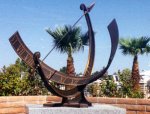 |
Mesa |
Arizona |
USA |
Equatorial Dial |
Dial 302 |
| Very handsome equatorial dial of bronze and marble, approximately 50 in. diameter. Sits on a triangular base atop marble pedestal 39 in. x39 in. x24 in. high. Inside brick-walled enclosure about 21 in. square. |
| |
| |
 |
Mesa |
Arizona |
USA |
Analemmatic Dial |
Dial 801 |
| This concrete analemmatic dial is set is a larger concrete plaza located in a City park with an overall theme of Sonoran Desert environmental education and nature-based play. |
| |
| |
 |
Mexico City |
Distrito Federal |
Mexico |
Horizontal Dial |
Dial 453 |
| A triangular based horizontal dial with a triangular moat. The outer triangular sides are approximately 12 feet (4 meters). The dial and moat are built of concrete, with an aluminum or sheet metal gnomon about 150 cm. On the dial are metal pyramids to indicate hours. The sundial was donated by the Tecnologico de Monterrey University. |
| |
| |
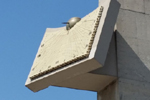 |
Mexico City |
México |
Mexico |
Vertical Dial |
Dial 1001 |
| This is a south facing reclining vertical sundial made of stone about one and a half meter square. The dial's concrete mount adjusts the dial to true south even though the carillon tower is not N-S aligned. Hour lines and Roman numbers on the dial go from 7am to 5pm. Monthly declination lines show the date as well as the solstices and equinox. A simple rod gnomon exits a gold ball at the top of the dial. The dial itself is well above eye level and hard to read. The other end of the carillon tower has an Aztec calendar. |
| |
| |
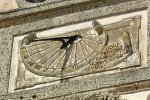 |
Miami |
Florida |
USA |
Vertical Dial |
Dial 785 |
| An east-declining vertical dial near the top of a stone winter residence building, now a museum. Dial face includes hour lines and Roman hour numerals for 5 AM to 3 PM. Building and dial were built in the early 1900s but gnomon appears to be in good condition without corrosion so it may be bronze. Dial includes a depiction of a scroll with engraved Latin inscription. |
| |
| |
 |
Miami |
Florida |
USA |
Analemmatic Dial |
Dial 573 |
| A 16 foot diameter analemmatic dial of broken mosaic tiles. The numerals, months and lines are made with broken colored tiles. The major axis is 10 feet. A movable vertical gnomon is available for increased reading accuracy but a standing child is the usual gnomon. The colored number tiles are white for DST and black for ST. |
| |
| |
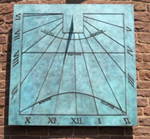 |
Middletown |
Connecticut |
USA |
Vertical Dial |
Dial 922 |
| This 6 x 6 ft. bronze, vertical sundial faces directly south on the curved sandstone wall of the Observatory. This dial was fabricated of Muntz metal bronze that received a hot applied green patina to compliment the brown sandstone color of this 1916 university observatory. Because of its large size, the metal dial weighs 650 lb. The hour numbers and lines are raised and applied to the surface of the dial. The Roman hour numbers that surround the dial plate in a frame take their shape according to the hour angle. Declination lines of the solstices and equinox are marked by the triangular gnomon shadow tip. The dial includes a built in longitude correction to show solar time for the time zone meridian. On a nearby wall below the dial, a plaque features an analemmatic graph for the equation of time correction to get clock civil time. |
| |
| |
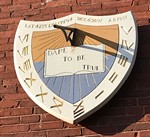 |
Milton |
Massachusetts |
USA |
Vertical Dial |
Dial 92 |
| A vertical south facing dial made of painted mahogany with an aluminum gnomon. The dial is in the shape of a shield 3 foot tall by 2 1/2 foot wide, following the seal of the Milton Academy. Around the edge are the hours in Roman numeral. An Equation of Time correction table is now missing, but does not detract from the beauty of the dial. The dial is kept in excellent condition in red, blue and gold motif. |
| |